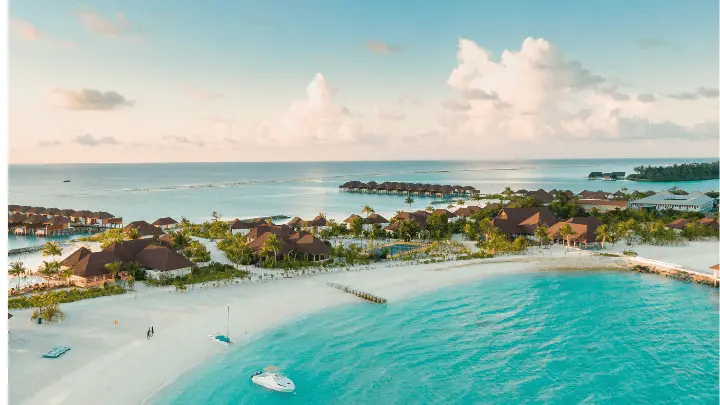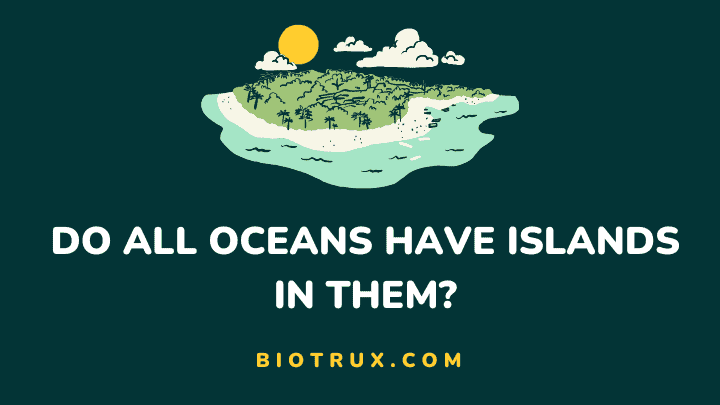Oceans have always captivated and mystified humankind. It is a world of its own, with its wondrous creatures, vast expanses of water, and incredible depth. But have you ever wondered if all oceans have islands?
Islands are landmasses that rise above the water level and are surrounded by the ocean. While some oceans are dotted with islands, others appear to be island-less.
Join me on this fascinating journey as I explore the depths of the world’s oceans and discover if all oceans have islands.
Overview of Oceans
Our planet has five major oceans: the Artic, Indian, Southern, Atlantic, and Pacific. The Pacific Ocean is the largest of the five, covering about 63.8 million mi², and the Arctic is the smallest, spanning about 5.4 million mi².
Oceans play a vital role in the planet’s ecosystem, serving as a habitat for countless species and producing more than 50% of the world’s oxygen. In addition to their environmental importance, oceans are a major source of economic activity, providing food, transportation, and energy resources.
The oceans may seem vast and untouchable, but their health and sustainability are crucial to the health and well-being of the entire planet.
Overview of Islands
Islands are a fascinating geographical feature of our planet. From tiny coral atolls to vast landmasses like Greenland, there are about 900,000 islands worldwide. They can be found in the Earth’s oceans and are often known for their unique ecosystems and cultures.
Some of the world’s most famous islands include Bali, Hawaii, the Maldives, and the Caribbean Islands. The biodiversity found on many islands is unparalleled, with species of plants and animals found nowhere else on Earth.
Many islands are popular tourist destinations and offer visitors opportunities to experience breathtaking landscapes, wildlife, and cultural experiences.
Types of islands
Islands can be classified into different types based on their origins. Some common types of islands include:
- Continental islands: These islands were once part of a larger landmass but became separated due to rising sea levels or other geological processes.
- Volcanic islands: These islands are formed through volcanic activity, where molten rock (magma) rises to the surface and solidifies, creating new land.
- Coral islands: Also known as atolls, these islands are formed by accumulating coral reefs on submerged volcanic or oceanic islands.
- Barrier islands: These long, narrow islands are parallel to the mainland and protect the mainland from storms and erosion.
Relationship Between Oceans and Islands

The primary way oceans and islands are related is through the geological process of plate tectonics. This process occurs when the earth’s crust moves over the molten mantle, causing plates to move and collide.
This movement has created some of the world’s most well-known island chains, such as Hawaii and the Galapagos. Islands near oceanic ridges, where tectonic plates meet and create underwater mountain ranges, are also formed through volcanic activity.
These islands are commonly found in the Pacific Ocean and are often part of a larger island chain. Erosion and deposition also contribute to the formation of islands. Over time, the constant action of waves, wind, and currents can erode the mainland, leaving behind isolated land masses.
The Outer Banks in North Carolina, USA, is an example of barrier islands formed through this process. Oceans also play a vital role in the ecosystem of islands. Oceans bring essential nutrients to island soil through erosion, which aids in the growth of plants and other vegetation.
Additionally, the water surrounding the islands is home to a diverse range of marine life that supports the island’s ecosystem. Furthermore, islands often profoundly impact the surrounding ocean’s ecosystems. Islands can affect ocean currents, create marine life habitats, and even modify the ocean’s climate.
Some islands also act as natural barriers, protecting surrounding coastal areas from the adverse effects of storms and tsunamis.
Do All Oceans Have Islands in Them?
Yes, all oceans have islands in them. Some islands are small and uninhabited, while others are large and densely populated. Many of the world’s most populous countries, such as Japan and Indonesia, are made up of islands.
Islands in the Pacific Ocean
The Pacific Ocean is Earth’s largest and deepest ocean, containing countless islands and archipelagos. Hawaii in the Central Pacific is a well-known archipelago formed by volcanic activity. Other notable Pacific islands include Bora Bora, Tahiti, and Fiji.
Islands in the Atlantic Ocean
The Atlantic Ocean is home to numerous islands, both large and small. Greenland, the world’s largest island, is located in this region.
The British Isles, including the United Kingdom and Ireland, are located in the northeastern part of the Atlantic Ocean. Other notable islands in the Atlantic include the Azores, the Canary Islands, and the Falkland Islands.
Islands in the Indian Ocean
The Indian Ocean is home to several island nations and archipelagos. The Maldives, a popular tourist destination, consists of a chain of coral islands.
The Seychelles, located off the eastern coast of Africa, is another prominent island group in the Indian Ocean. Mauritius is also an island located in the Indian Ocean.
Islands in the Southern Ocean
The Southern Ocean surrounds Antarctica and is known for its rugged and remote islands. South Georgia and the South Sandwich Islands, located in the southern Atlantic Ocean, are part of this region. These islands are uninhabited and mainly serve as wildlife sanctuaries.
Islands in the Arctic Ocean
Although predominantly covered with ice, the Arctic Ocean contains a few islands. Greenland, the world’s largest island, is bounded on the north by the Arctic Ocean. The Canadian Arctic Archipelago, consisting of numerous islands, is also part of the Arctic Ocean.
Factors Affecting Island Formation
1. Tectonic and volcanic activity
Tectonic activity is one of the main factors that contribute to island formation. This activity refers to the movement of the Earth’s plates that can create volcanic eruptions and earthquakes, both of which can lead to the formation of islands.
When tectonic plates move and collide, magma can rise to the surface, forming new land. Over time, these volcanic islands can be eroded by wind and water, forming coral reefs and atolls.
As volcanic and seismic events give rise to new land masses, tectonic activity is crucial in forming islands. The Pacific Ring of Fire is a prime example of a region with intense volcanic activity and the formation of volcanic islands
2. Erosion and deposition
The constant action of waves, wind, and currents can erode the mainland and deposit sediment in specific areas, forming islands. Barrier islands, for example, are formed through the deposition of sand and sediment parallel to the mainland.
3. Sea level changes
Sea level changes, such as rising or falling sea levels, can also contribute to island formation. When sea levels rise, low-lying areas may become submerged, creating islands. Conversely, previously submerged land may emerge when sea levels fall, forming new islands.
FAQs
Are all islands in oceans formed by volcanic activity?
No. Not all islands in oceans are formed by volcanic activity. Islands can also be formed through tectonic activity, erosion and deposition, and other geological processes. Coral islands, for example, are primarily formed by accumulated coral reefs on submerged land.
Can islands disappear over time?
Yes, islands can disappear over time due to various factors. Erosion, sea level changes, and tectonic activity can all contribute to the disappearance of islands. Additionally, human activities, such as mining and land reclamation, can also result in the loss of islands.
Are there any man-made islands in the oceans?
Yes, there are man-made islands in the oceans. For example, the Palm Jumeirah and the World Islands in Dubai, United Arab Emirates, are artificial islands created through extensive land reclamation projects.
Can islands move?
Islands, as solid landmasses, do not typically move. However, the plates they are located on may shift or drift due to tectonic activity. This movement can change the position and orientation of islands over long periods.
Final Thoughts
While all oceans have islands, some are small and inhabited. The vastness of the ocean and its ability to support life in various forms is truly remarkable. Islands play a crucial role in this ecosystem, providing habitats for numerous species and serving as an inspiration for humans.
While we may not know all the secrets that the oceans hold, the existence of islands reminds us of our planet’s vast and dynamic nature.
Whether exploring the world’s remote corners or relaxing on the beach, let us appreciate the oceans’ beauty and diversity.
I hope you found this article helpful. If so, why not check out the US states that border the ocean.
Thanks for reading.

